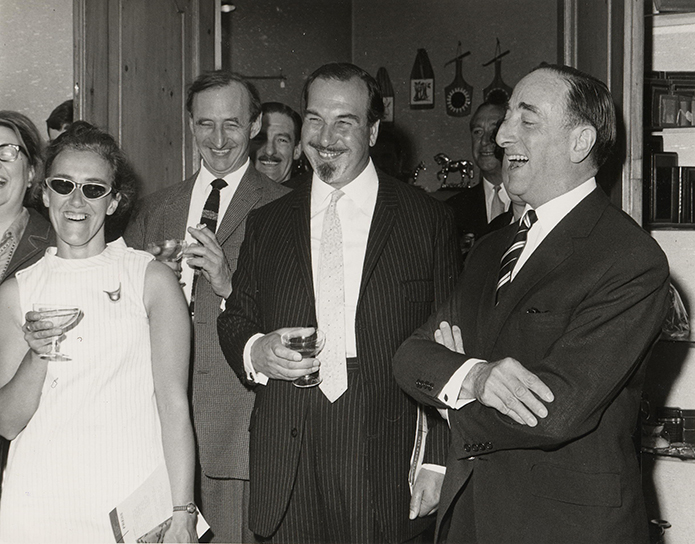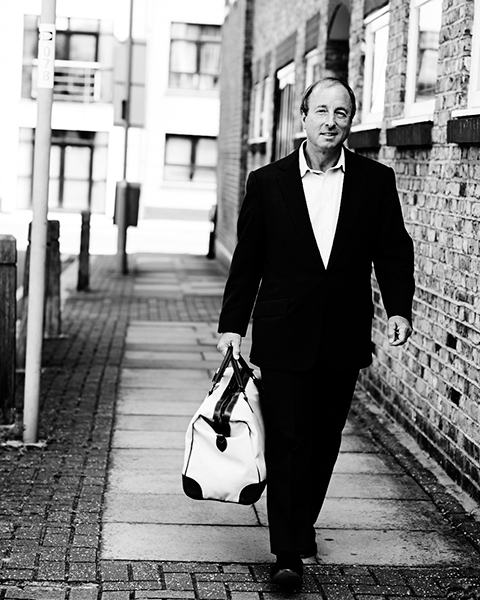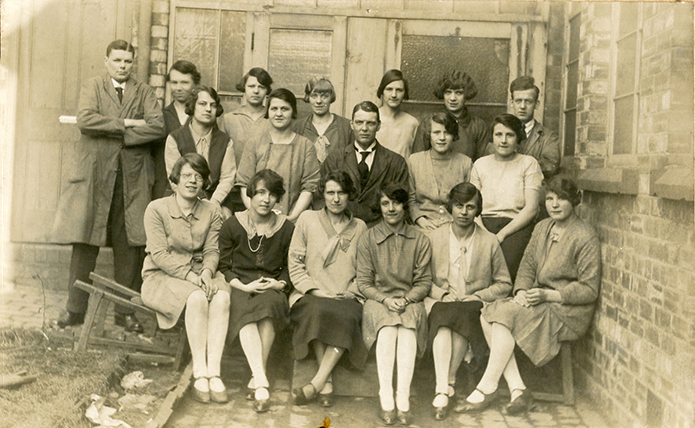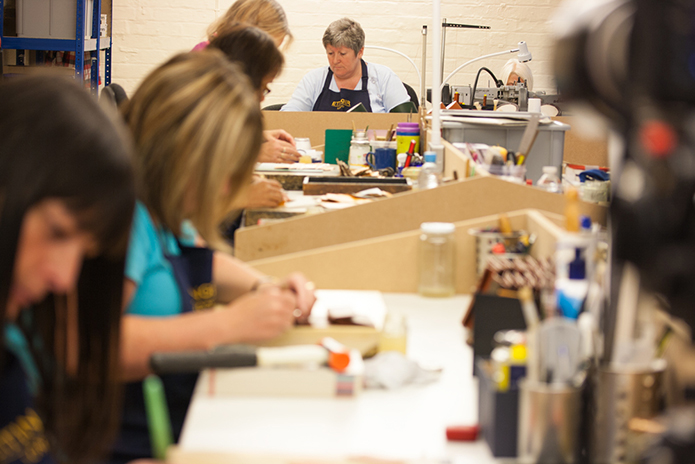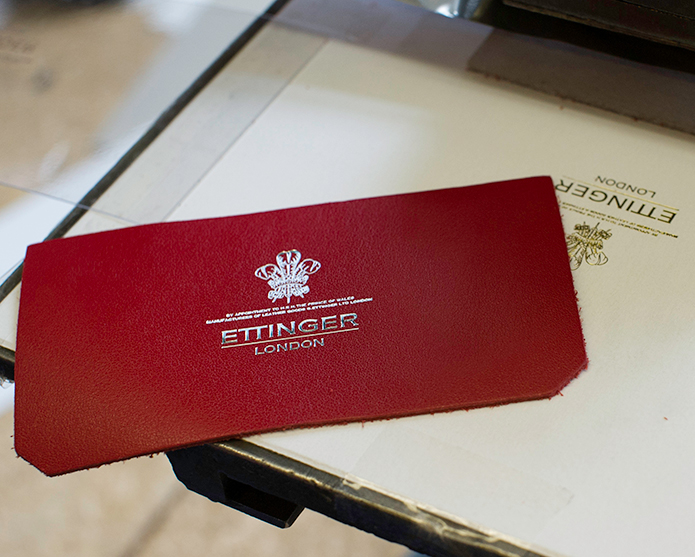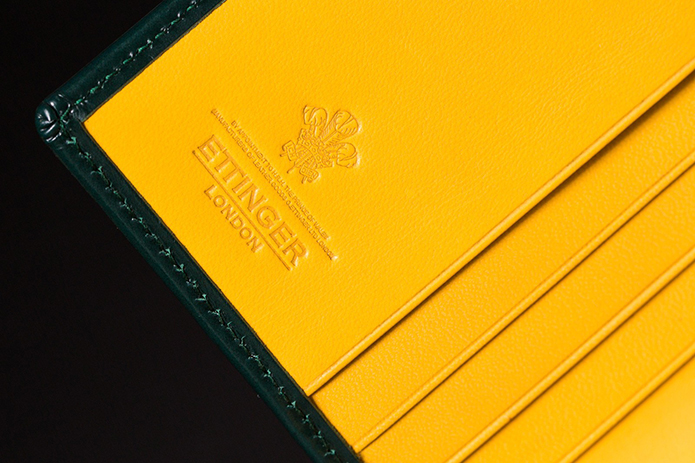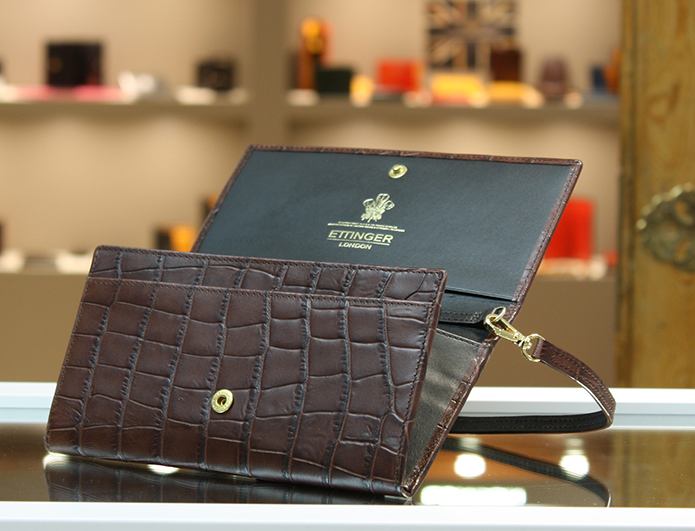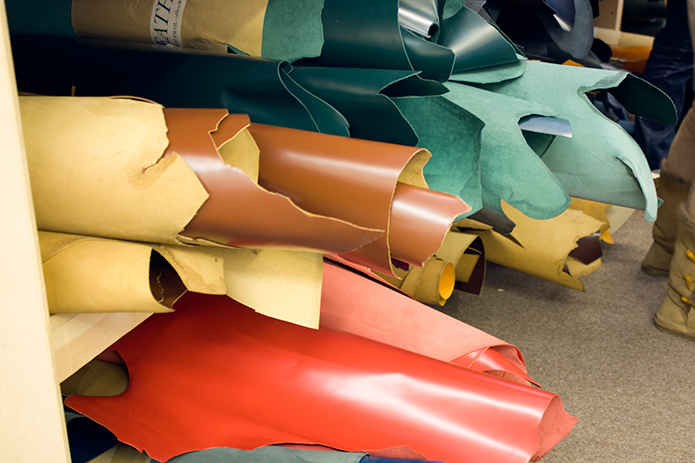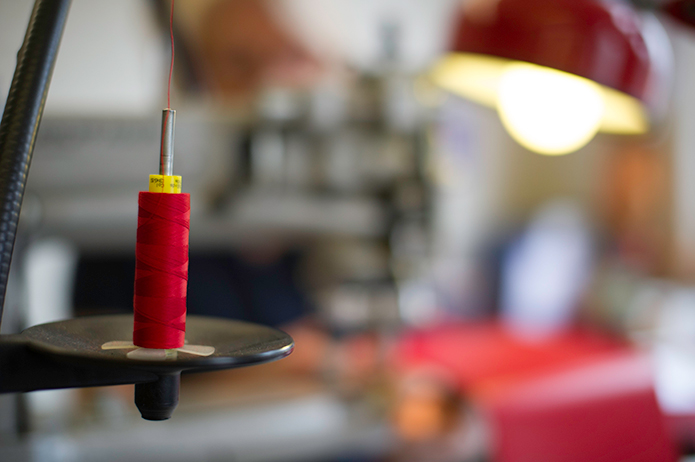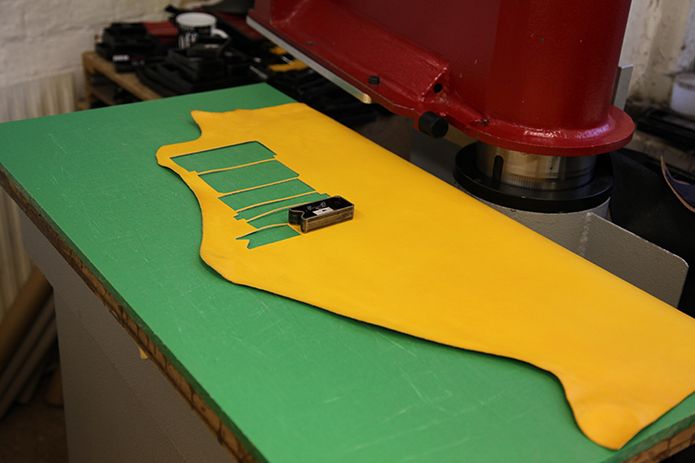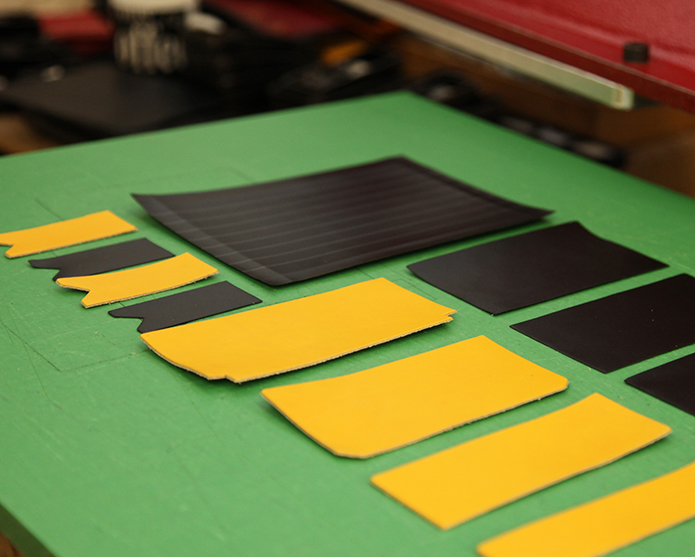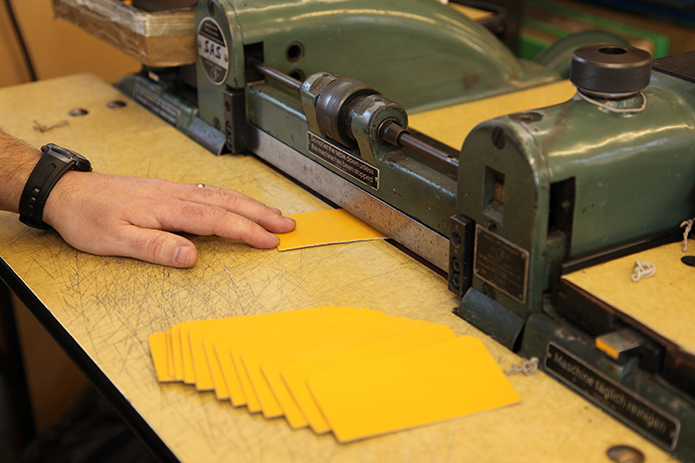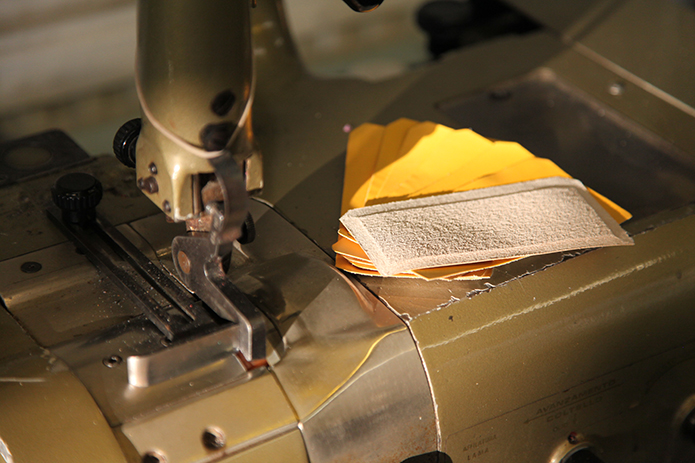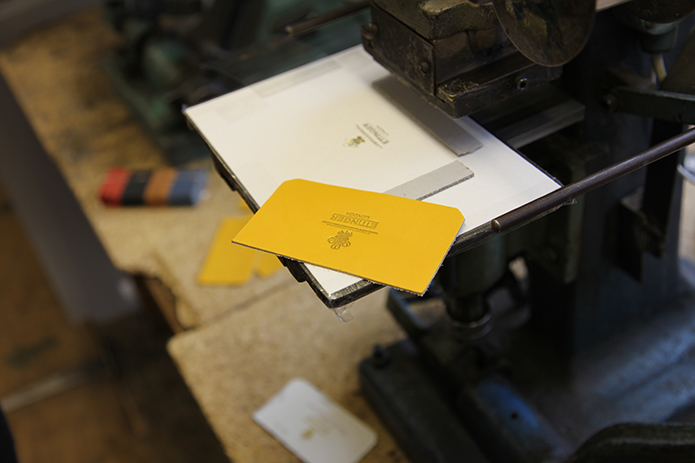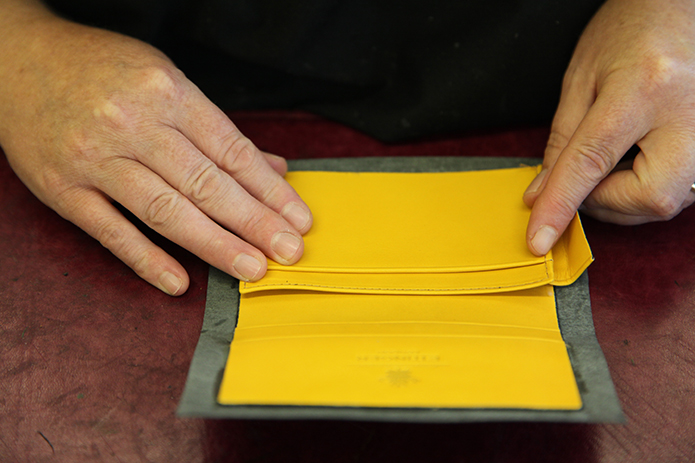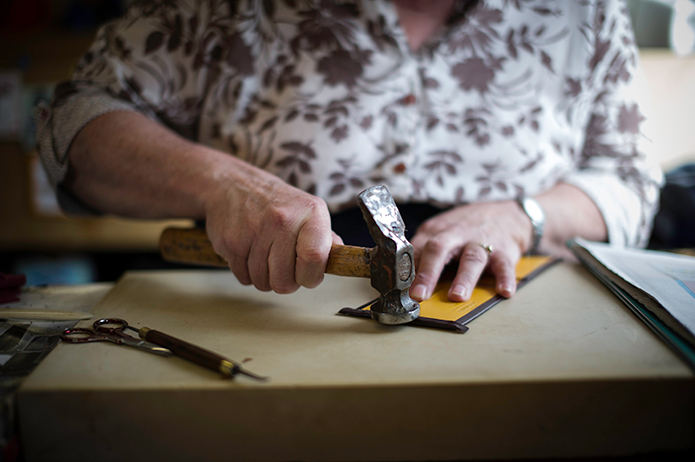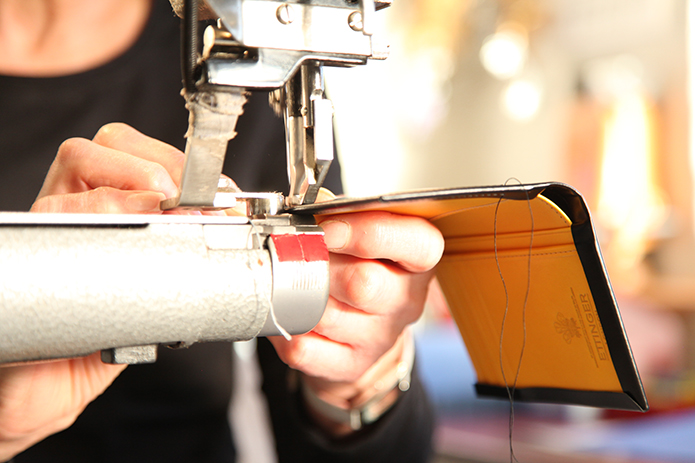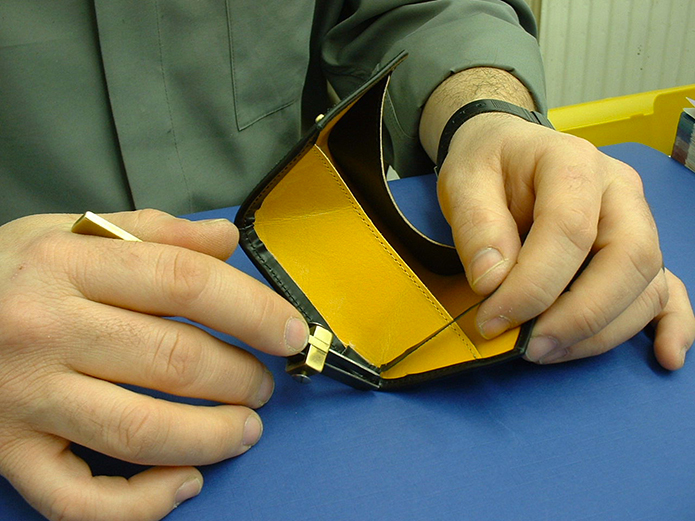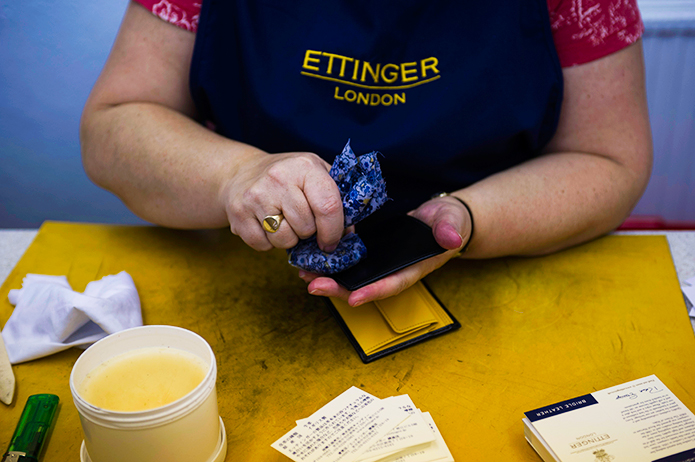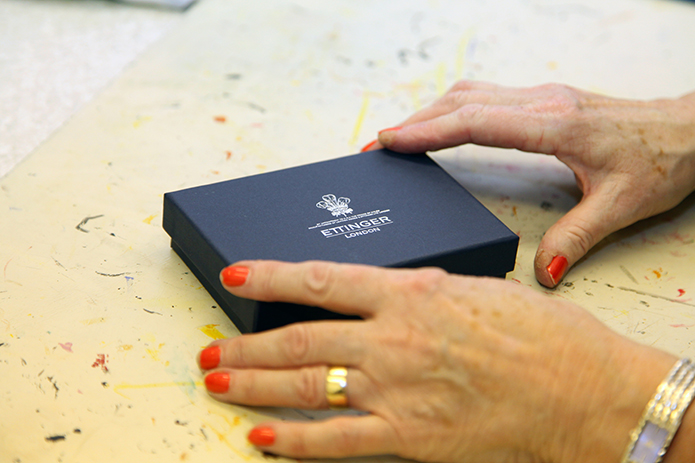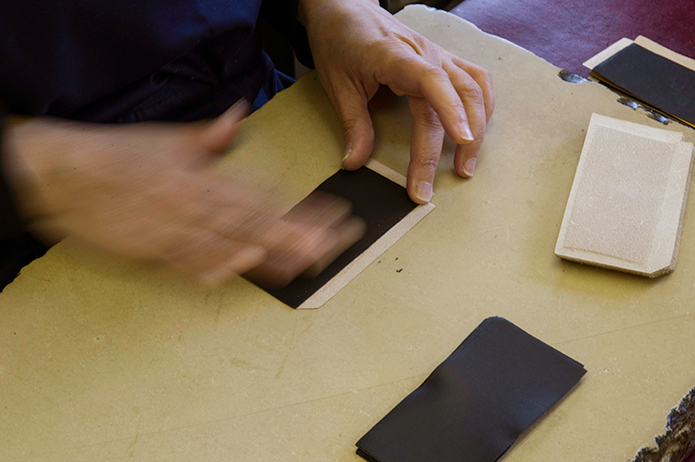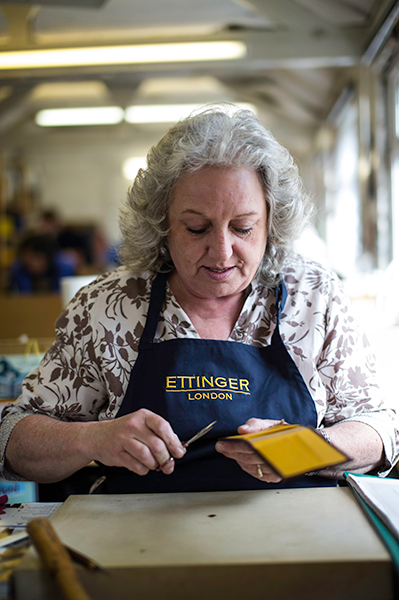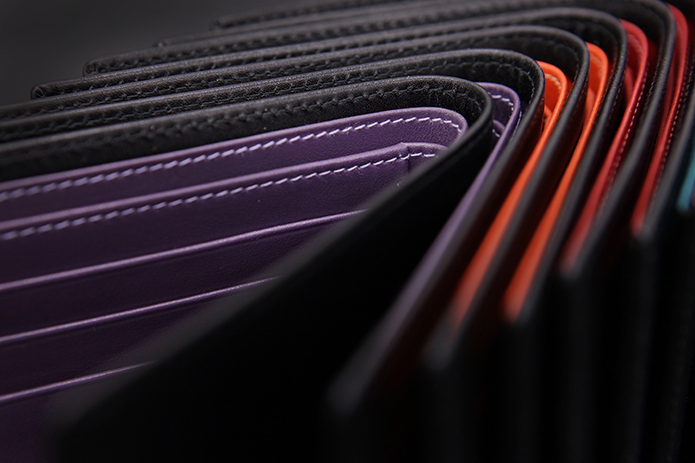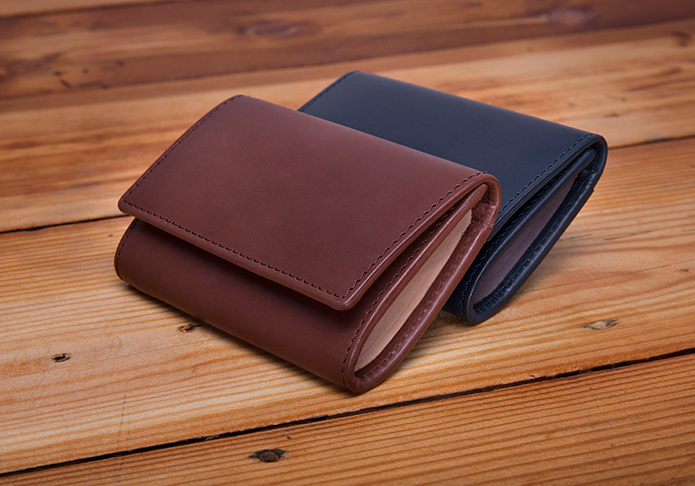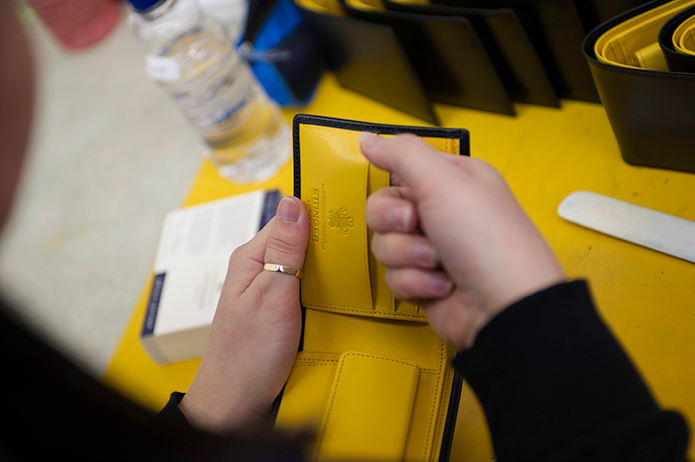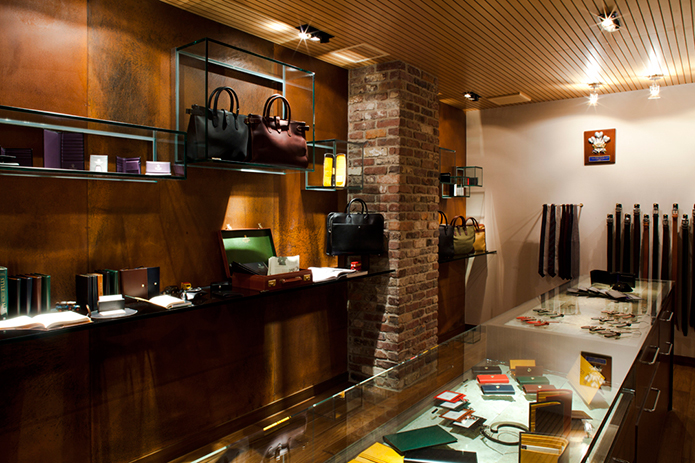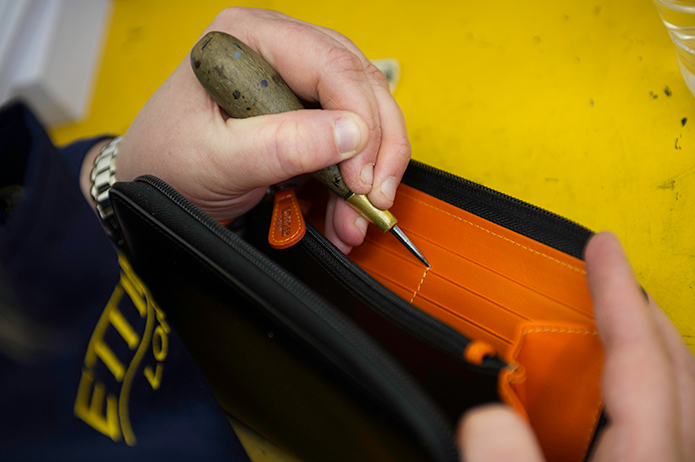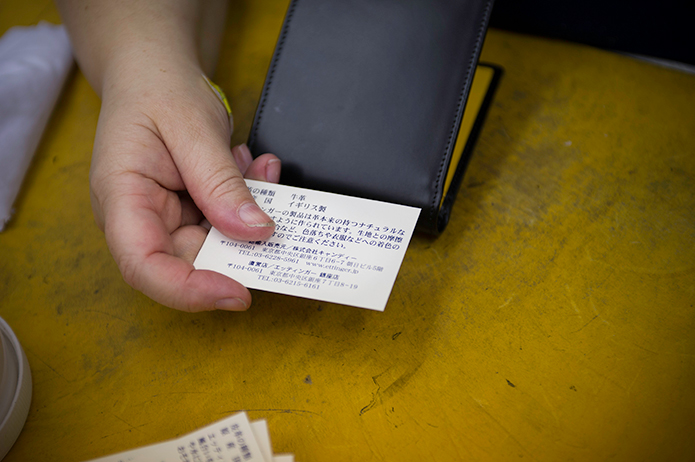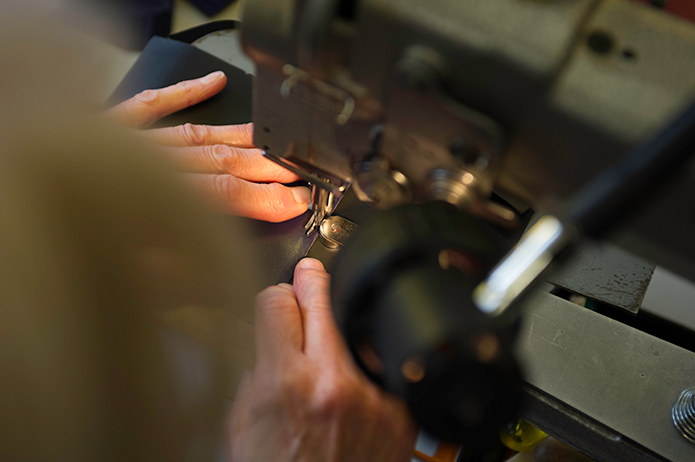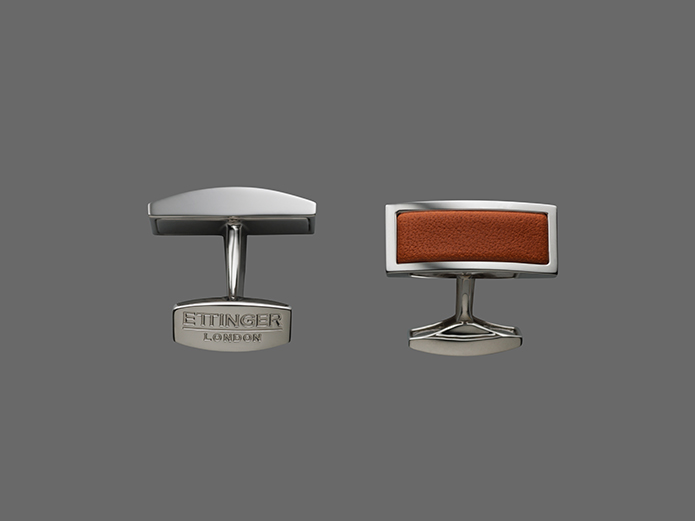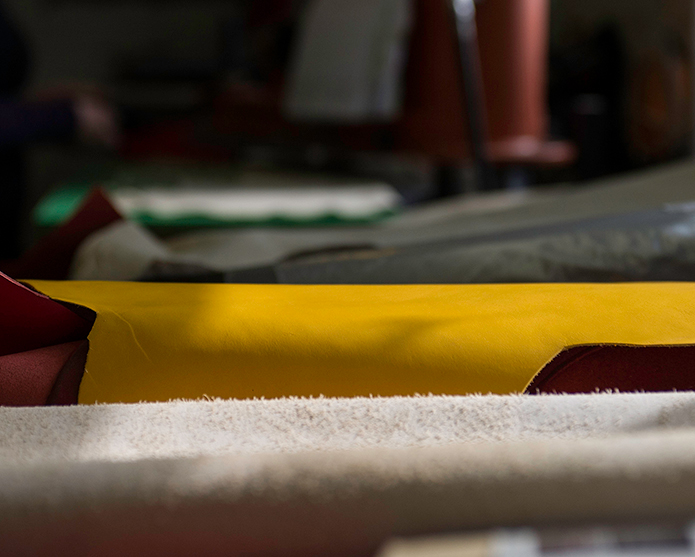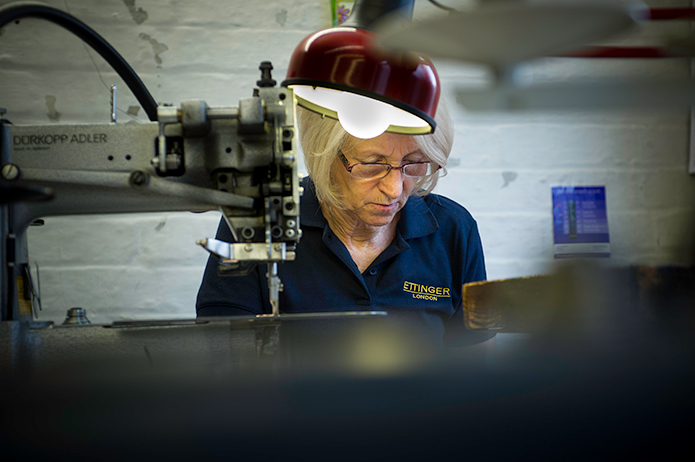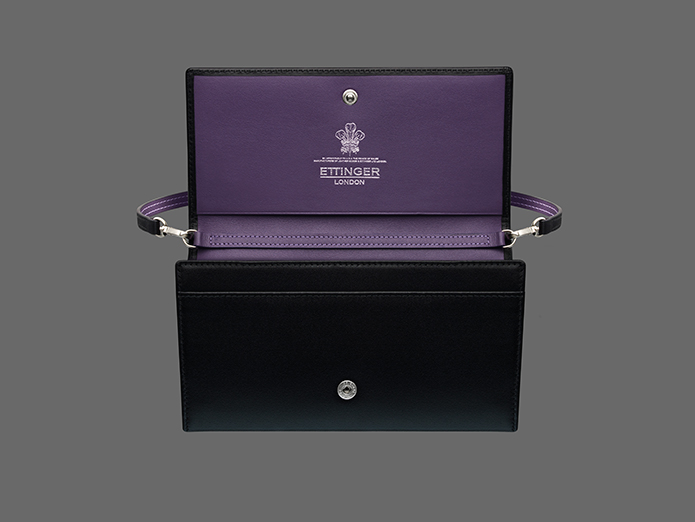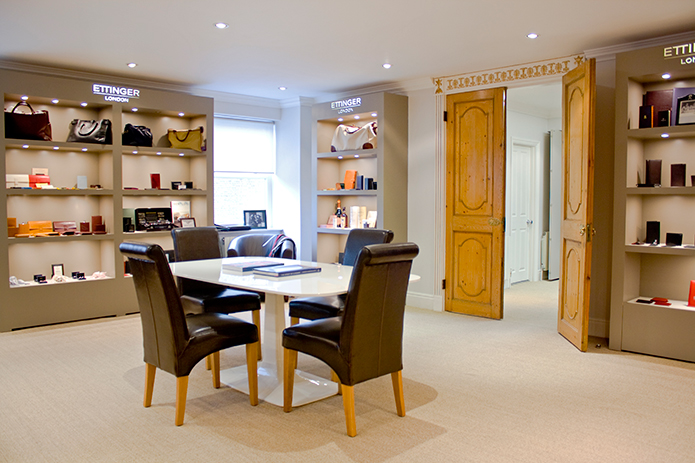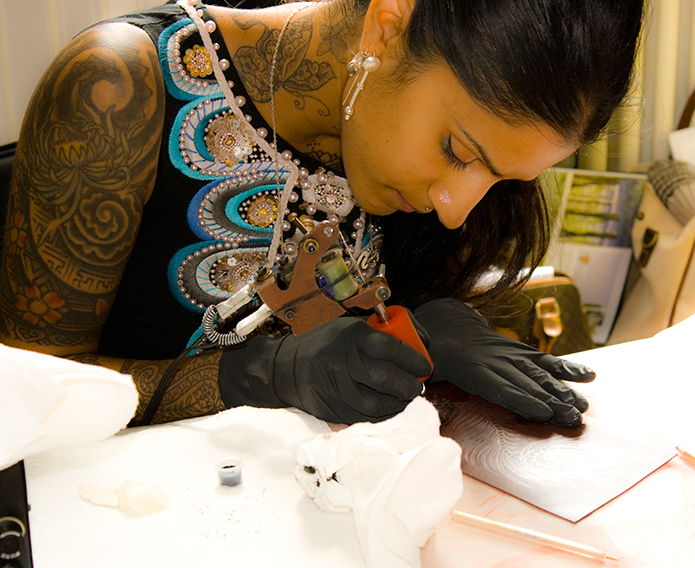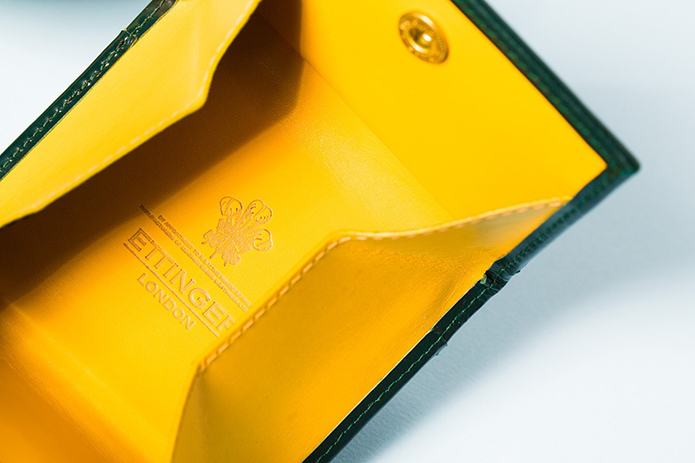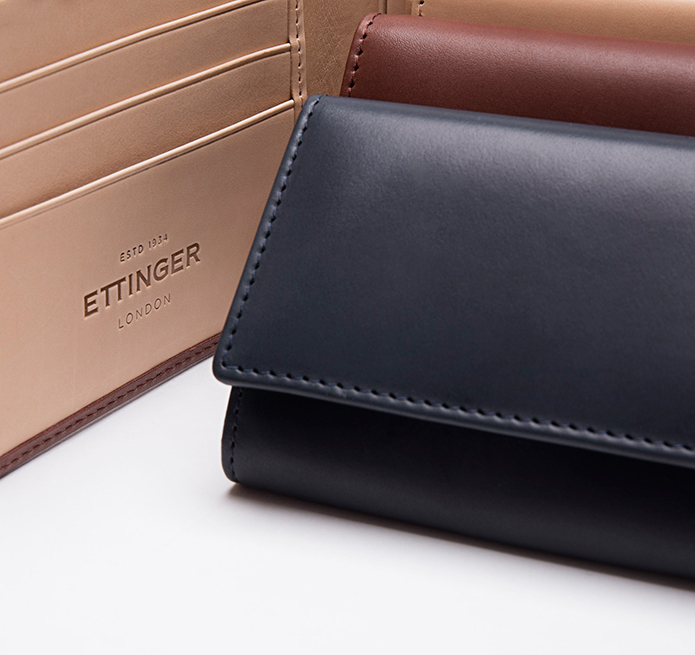
Let us fast forward the history of leather – the ultimate raw material of millennia, when since prehistoric times each evolving civilisation has enjoyed both its durability and aesthetic qualities, in terms of look and feel – into more modern times, since the 1930s, when this timeless and humble material has been expertly crafted into elegant gentlemen’s accessories by British leather workers in the leather-making heartlands of London and Walsall, under the family name of Ettinger. Ettinger was born from the adventurous career of Gerry Ettinger, evolving from a pre-war film producer, surviving the tumultuous war-time years, to a post-war businessman using his European connections and charisma to supply Harrods, Fortnum & Mason and Asprey with luxury leather goods.
Now, with a Royal Warrant from the Prince of Wales, a presence within luxury retail stores around the world and a global command of the high-end consumer market, third generation Ettinger is firmly on the international brand-map as the manufacturer of quintessentially British luxury leather goods, hand-crafting traditional accessories with a contemporary feel; most recently launching a collection honouring the patron saint of leather workers, Saint Crispin. Ettinger is an extremely successful exporter of this most British of brands, with a range of collections relating to Bentley, brogues and pinstripes, and continues to sell ‘hell-for-leather’ in Japan and more recently in Taiwan, Korea and the Middle East, with more expansion imminent. Ettinger’s success is due to its appeal to a broad spectrum of customers related by their appreciation of high quality materials, exemplary craftsmanship and timeless design and, of course, a love of all things leather.
So, thank heaven for leather, and for Robert Ettinger, son of the founder Gerry Ettinger, who as Chairman, CEO and owner, as well as an extremely well-seasoned traveller, linguist, ski-instructor (where does he find the time..?) has ensured that the brand Ettinger continues to evolve and prosper; proving as timeless, durable and aesthetic as leather itself. Here we are lucky to gain an insight into Ettinger in the words of Robert himself…
Firstly, for those readers who aren’t familiar with Ettinger, please can you tell us about the history of your company?
Ettinger was started in 1934 by my grandfather as well as my father, who was very young at the time. Initially the business imported leather goods from mainland Europe, albeit with disruptions due to the Second World War, but in the 1950s Ettinger acquired a leather goods manufacturing company renowned for its craftsmanship in the leather-making area of London, near Smithfield Market, on St John’s Street. At the time, this area of London was renowned for its leather-making industry; there were lots of tanneries on the River Thames – there are still street names reflecting this trade, such as Tanner Street and Leather Lane – and up the side streets from the river you had the leather manufacturing areas and the factories making wallets, purses and luggage. They were making high-end leather products here in London, the top end of the market. Another area of the country famous for its leather production was Walsall, a large town in the Midlands, although traditionally it focussed on the lower and middle-end of the market as well as saddlery. The size of industry was much larger in Walsall than London back in the 1920s and 30s, employing as many as fifty thousand people in the numerous saddleries and tanneries, although there are now only a few hundred employed in the leather industry in Walsall, and it’s virtually non-existent in London.
We continued making our products in the Clerkenwell area of London until about fifteen years ago, by which time it had become gentrified and the old factories had become converted to restaurants, offices and the like, and it simply no longer became feasible or viable to maintain production there, sadly. In 1999, we acquired a larger company in Walsall, James Homer Ltd, which had been in existence since 1890, to continue our production.
Over the following five years we gradually transferred our production facility from London to Walsall, as well as some of the workforce that were able to relocate. With Walsall being a leather town, it gave us access to a larger trained workforce at a time when we were experiencing real growth in demand for our products, so it was a case of it being the right time and place for us to make the move.
Ettinger has always operated at the top end of the market. For decades we were making for other companies such as Aprey, Harrods and Fortnum & Mason under their own name, but in 1996 we received the Royal Warrant, and decided we wanted to build on the Ettinger brand. The Royal Warrant provides a seal of approval, a mark of quality and a sense of reassuring trust in our brand, which has been tremendously important for us, particularly internationally, as exports account for 90% of what we make, and we put the Warrant on our products and packaging and include it within our advertising campaigns.
We are very much a niche brand, which people like these days; people are looking for something more niche in their luxury items, something that not everyone has.
Ettinger is regarded as makers of the quintessential British luxury wallet. Can you define the uniqueness of your wallets and why they are so special?
It’s amazing how iconic our collections have become, some of which date back to the 1940s & 1950s, and haven’t tired at all. These collections use bridle leather for the exterior of the wallet, which is a quintessentially British leather traditionally used in the making of horse bridles, saddles and other tack, and panel hide leather for the inside, which was traditionally used for the underside of saddles and is a vegetable- tanned leather, made without using chemicals to avoid any irritation on the horses skin when sweating. Only natural substances are used to soften the panel hide and it’s this which gives its lovely London Tan colour. Our wallets are handcrafted in very much the same way as they always have been, using British leathers whenever we can.
You’re very well known as a designer and manufacturer of classic wallets for men. Is that still true today or have you developed the range into other luxury leather goods, and have you created a range for ladies as well?
We have certainly developed the range, and whilst we’re still very well known for our wallets, our design team have developed a wide range of other leather accessories and bags. Traditionally, we had focused on products for men, but about eight or nine years ago we developed a range for women; we found that women who accompanied men to the shops to purchase Ettinger products would love the design and quality of what we made but we didn’t have anything for them, so it made complete sense to create a whole range of accessories for women as well – the logic being that if we can make a wallet, we can make a purse. We’re building that side up now, by creating ranges of purses, clutches, jewellery rolls and boxes, as well as travel accessories and items for the home.
How important is maintaining full production of your leather products in England?
It means a huge amount to us. It’s only really financially viable to make items in England now if you’re making premium or luxury leather products as they’re more expensive to make than in mainland Europe or the Far East. It’s lucky that Ettinger has always been at the top end of the market which has allowed us to carry on as we always have done, whilst sadly many others haven’t been so fortunate.
Maintaining full production in England gives us total control over raw materials, production and the finish. If the materials aren’t good enough, for instance, we can simply send them back, which we certainly couldn’t do if we outsourced production to the Far East.
By way of an insight into the artisanal nature of your work, could you briefly describe the process of crafting one of your leather products, such as a wallet, and explain some of the key stages?
It all starts with the raw materials – we source the best leathers, best linings and best threads – without that our products won’t look very good, irrespective of the skill that goes into making them.
Once the leather comes in from the tanneries, 85% of the process is carried out by hand. The leather arrives in whole skins, which are then cut up into specific shapes ready for assembling using metal cutters or razor sharp knives.
Each piece is then thinned to a uniform thickness using a splitting machine, and edges are thinned using a skiving machine.
The company logo, Royal Warrant and any other markings are ‘blocked’ onto the leather pieces using a hand-operated machine, which requires great skill to operate.
The leather pieces are then put together and any linings and backings are glued, the leather turned over, crease lines added and edges hammered to ensure they are flat and any glue is well stuck.
Each piece is then stitched using special sewing machines, ensuring a set number of stitches per inch.
The last few stages involve trimming the edges by hand for a refined look.
They are then checked and then given a final polishing ready for careful packing.
However, I’m not sure that ‘artisanal’ is the best description for what our craftsmen and women do, as artisanal sounds as though they’re making one-off products. There’s a huge amount of skill within the overall process, not just in producing items of the highest quality, but in the speed to make lots of products by hand to make the business profitable. The combination of quality and speed is a great skill, and the workforce makes it look easy, but I can assure you it’s actually incredibly difficult.
Many of our staff are second, third, even fourth, generation workers, and some remember coming in and looking around when their parents worked here; they really do understand what they’re doing.
Your inspired designs have captured a wide range of influences, such as gold bullion, brogues, pinstripes, luxury cars & hotels, royalty and more recently the patron saint of leather, Saint Crispin. Could you provide some insights into what inspires you and your design team, and how do you interpret these ideas and turn them into a collection?
It normally takes between six and twelve months to launch a new collection, from initial ideas to getting the product on the shelf. With our wallets and purses, you can’t really re-invent the wheel with designs – they are designed to only really hold cash, credit cards and business cards – and therefore we do have style constraints due to the size of the items, unlike handbags, for instance. So colour and finish are the intrinsic design aspects and it’s open to our design team to come up with good ideas.
Our recent Saint Crispin collection is a good example of what happens when we hit upon ideas for a new range. We wanted to produce a really beautiful new collection for our 80th anniversary year, and to start off we had to find the best leather, which we did with a wonderfully soft, burnishable calf leather, which over time will just keep getting better and better. Once the type of leather had been decided upon, getting the right colourway was the next step – which normally involves talking to lots of people, such as the public, customers, colour consultants and designers – to consider the various options. It’s only when these steps have been taken that our design team could set about creating new design concepts, which consists of looking at fresh ideas as well as finding old favourites from our archive. The design team came up with the idea of honouring Saint Crispin, the patron saint of leather workers and cobblers, for our collection, which was very fitting and celebrates the absolute finest leather craftsmanship.
Whilst style is exceptionally important, it’s important that we make our products as practical as possible. We worked on a travel wallet that took 18 months to design, but after three weeks on a business trip to Japan, we realised that it wouldn’t quite fit in the hotel safe, so we needed to make some refinements. It takes time to make things work, and it’s certainly not just about making items look pretty.
Ettinger opened its first directly managed store in Tokyo as recently as 2010. Why did you choose Japan for the launch, rather than, say, London, Beijing or New York?
We’ve been selling to Japan for decades, and it was then, and still is now, our most important overseas market and our brand awareness is very strong there. We felt that with the presence we have there, it was the logical place to start. The Japanese really love Ettinger; they appreciate quality workmanship and attention to detail in their products, and they really like what we have to offer. The fact our products come with the Royal Warrant – the Royal seal of approval – also helps.
The Japanese are very interested in the heritage and provenance of products, and the making of things – the quality of the stitching and the turnovers, for instance, and the leather itself – in fact more so than anywhere else.
It isn’t just older people either; it’s anyone from seventeen years old to eighty that likes the Ettinger brand. I was in Tokyo last year and as I was leaving the hotel for the airport, I was talking to a young hotel porter who was helping me with my luggage; he could only have been seventeen years old, but he pulled out an Ettinger wallet and with enormous pride told me it was his favourite possession. For an item that would have cost circa £300, that was a big investment for someone of his age. He was really chuffed to be talking to me about Ettinger, and I was really chuffed to witness his passion for the brand!
Are there differences in the style of products you make to account for different tastes in international markets?
I think we have taken into account differences from both a style and production perspective. Many years ago, when we first started selling to Japan, we dispatched an order to Tokyo but a number came back from the distributor as not being good enough for them, which was a surprise, as it was good enough for the likes of Fortnum & Mason and Harrods! Shortly after that I went over to Japan with some of the rejected samples, and was taken to an inspection room and under a magnifying glass, it was pointed out to me that in some parts of the wallet there were twelve stitches to the inch, whereas in other parts there were thirteen stitches to the inch. It wasn’t a question of overall quality, and it was easy to change our stitching to ensure there were twelve per inch across the board, but it just reflected a difference in state of mind. Now we work to the Japanese standard for all our items, which has allowed us to improve production to a standard higher than the exceptionally high benchmark that we had set ourselves previously.
We have also made some alterations to our designs to account for different international tastes, particularly for the Japanese and Chinese markets. In Japan it is considered unacceptable and dirty to put coins in a suit pocket, so we developed our wallets to have an extra compartment to hold coins, which is something we wouldn’t really think about in Britain. In China, we made some alterations to our purses and zip wallets to account for the fact that they have a tendency to carry more cash than we do in the UK. Within reason, we will certainly make adjustments and product refinements for a specific market.
Is there such as thing as a ‘typical’ Ettinger customer?
About eighteen months ago Ettinger took on a new advertising agency and they asked me exactly the same question, and I told them there isn’t a typical Ettinger customer and they could range from the age of seventeen to ninety. This comment was met with disbelief, and they said that can’t be true – there must be a specific profile of a certain range – but it’s absolutely true! I showed them advertisements for Ettinger products in South Korean student magazines directed at youngsters, as well as advertisements directed at a more mature audience, and only then could the advertising agency really understand why there isn’t a typical customer. It’s certainly not just high fashion for 18-25 year olds, or those over fifty who have the money to buy something nice, Ettinger products are essentially timeless and hold broad appeal.
How important is the quality of leather in creating your products?
The quality of the leather is absolutely critical to us. Like any producer, the raw ingredients define the rest of the product, and that certainly applies to us. We work with tanneries in the UK, but if none of the leather is suitable, then we will source it from mainland Europe. We inspect everything that comes into our workshop, but before that, we will often inspect the individual raw hides and skins before they go into the tanning stages in the tanneries to ensure we are only getting the finest part of the skin. Remember, leather is a natural material and a by-product of another process, with marks and wrinkles, and we end up using only about 50% of the hide or skin, so quality control is of paramount importance to us.
As one of the last remaining producers of leather luxury goods made in Britain in the traditional way, Ettinger is a genuine British success story, and looks set to continue to flourish. What do you think are the main contributing factors for this success?
Having the product is crucial, but I think there are a number of factors which have allowed us to be successful, which are that our factory and entire design and production team are based here in the UK, that we are committed to making our products to an exceptionally high standard and that we spend a lot of time closely examining what we do to ensure we don’t let our standards slip and we continually strive to improve.
The location of our head office showroom in London has certainly helped us with selling to a very international audience – we have our entire sales, marketing and PR team based here – and they are responsible for getting our product out there, which is incredibly important. And, of course, the Royal Warrant – the seal of approval, the testament to quality – this has been hugely important for us.
Finally, what’s next for Ettinger; are we going to see the opening of further stores, further collaborations with designers, for instance?
We will continue exploring international growth and are planning a major push in both the Middle East and USA; both of which are tough markets. We are looking to have our products in more luxury stores worldwide to build our presence and as an example, we are going to be in a new store opening in Muscat, Oman, in the next couple of months – having our products in luxury retailers around the world is a good way for people to see our products and get to know the brand.
We will definitely be looking at further collaborations with designers, like we have done with Saira Hunjan, a famous female British tattoo artist, and the design agency PearsonLloyd, who we worked with on the TT Collection for the new millennium.
We are already working with a freelance designer for a new light luggage collection – attaché cases and business cases, for instance – which will be launched next year.
It’s a very exciting time for us, and whilst we are very ambitious, we are mindful that it needs to be controlled growth, and we don’t get ahead of ourselves.
Thanks to Robert Ettinger for taking time out of his busy schedule to answer our questions. All images © Ettinger.

